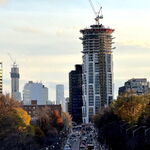nfitz
Superstar
True ... I was trying to keep it simple to drive home that this wasn't a powered car.They may LOOK similar and function the same as the existing cab cars, but structurally they are very, very different. These are built with stainless steel modules rather than aluminum, and the last 2 feet of each car is designed to compress in event of an accident - in concert with a number of other technologies and features, is commonly known as Crash Energy Management. And the 65 additional coaches on order for next year will also be built using these same features.
As the number indicates, this is the third unit built. There were photos of 301 on the assembly line in Thunder Bay floating around late last year, and 300 is apparently complete and being used for static testing.
Is 68-cars the entire order then? The rest aren't coming to 2016? Or are those 65 non-cab cars ...
I'd agree that these cab cars shouldn't drive ridership increases.And why would that be the case? That would be the equivalent of someone saying that the TTC's new streetcars will lead to an increase in ridership (which as we know does not happen). At best, a few 100 people will board the cab to see what it's like and it will have a negligible and temporary minuscule increase on the overall ride count.
And neither would new high-flow 15-metre TTC streetcars. However, on some routes (such as Spadina), the new streetcars should see some ridership increases from latent demand, given the inability of the current fleet from providing the best service, with cars trying to run too frequently, and decreased run times with less bunching and quicker boarding. Not to mention more accessibility.
Similar to how there's been a significant uptick in 512 ridership since the ROW was introduced.





